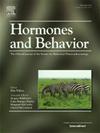产前双酚暴露、产后母亲护理和后代性别在预测与大鼠焦虑样行为相关的DNA甲基化中的相互作用
IF 2.4
3区 医学
Q2 BEHAVIORAL SCIENCES
引用次数: 0
摘要
产前暴露于内分泌干扰化学物质,如双酚类物质,可以改变神经发育轨迹,并通过表观遗传途径产生持久的神经行为影响。然而,与产前双酚暴露相关的结果也可能受到产后环境的影响,总的来说,这些环境影响可能是性别特异性的。因此,综合研究设计,包括多种早期生活暴露和考虑性别差异可能是预测结果的必要条件。在目前的研究中,我们使用多变量方法来研究产前双酚暴露,产后母亲护理和后代性别对成年龙-埃文斯大鼠腹侧海马和杏仁核中已研究的候选基因(NR3C1, BDNF, OXTR) DNA甲基化变化的贡献。研究一致发现,产后产妇护理和产前双酚暴露的主要影响是NR3C1基因(腹侧海马)和BDNF和OXTR基因(杏仁核)内的DNA甲基化。在所有的分析中也发现了性别特异性的影响。总的来说,我们的研究结果表明,早期生活因素(产前和产后)和后代性别都会影响与焦虑样行为表达相关的基因和大脑区域的DNA甲基化变化。这些结果强调需要考虑多重暴露对男性和女性大脑区域的特定影响,以了解早期环境的持久影响。本文章由计算机程序翻译,如有差异,请以英文原文为准。
Interplay between prenatal bisphenol exposure, postnatal maternal care, and offspring sex in predicting DNA methylation relevant to anxiety-like behavior in rats
Prenatal exposure to endocrine disrupting chemicals, such as bisphenols, can alter neurodevelopmental trajectories and have a lasting neurobehavioral impact through epigenetic pathways. However, outcomes associated with prenatal bisphenol exposure may also be shaped by the postnatal environment and collectively these environmental effects may be sex-specific. Thus, an integrative research design that includes multiple early life exposures and considers sex differences may be essential for predicting outcomes. In the current study, we use a multivariate approach to examine the contributions of prenatal bisphenol exposure, postnatal maternal care, and offspring sex to variation in DNA methylation of well-studied candidate genes (NR3C1, BDNF, OXTR) in the ventral hippocampus and amygdala of adult Long-Evans rats. Main effects of postnatal maternal care and interactions with prenatal bisphenol exposure were consistently found for DNA methylation within the NR3C1 gene (ventral hippocampus) and within the BDNF and OXTR genes (amygdala). Sex-specific effects were also found across all analyses. Overall, our findings suggest that both early-life factors (prenatal and postnatal) and offspring sex contribute to variation in DNA methylation in genes and brain regions relevant for the expression of anxiety-like behavior. These results highlight the need to consider the brain region-specific effects of multiple exposures in males and females to understand the lasting effects of early environments.
求助全文
通过发布文献求助,成功后即可免费获取论文全文。
去求助
来源期刊

Hormones and Behavior
医学-行为科学
CiteScore
6.70
自引率
8.60%
发文量
139
审稿时长
91 days
期刊介绍:
Hormones and Behavior publishes original research articles, reviews and special issues concerning hormone-brain-behavior relationships, broadly defined. The journal''s scope ranges from laboratory and field studies concerning neuroendocrine as well as endocrine mechanisms controlling the development or adult expression of behavior to studies concerning the environmental control and evolutionary significance of hormone-behavior relationships. The journal welcomes studies conducted on species ranging from invertebrates to mammals, including humans.
 求助内容:
求助内容: 应助结果提醒方式:
应助结果提醒方式:


